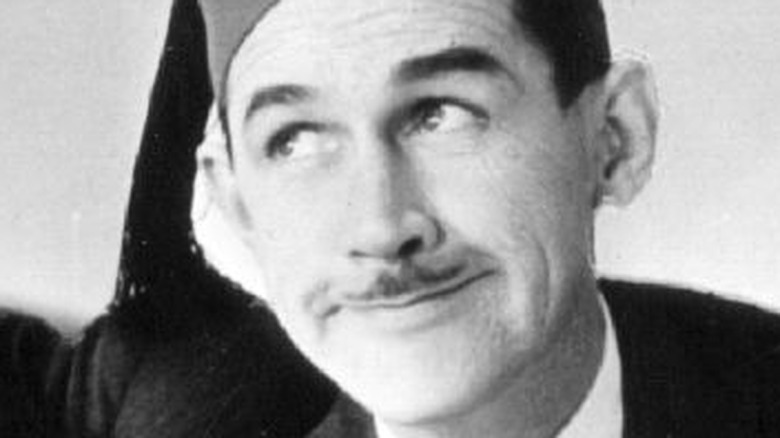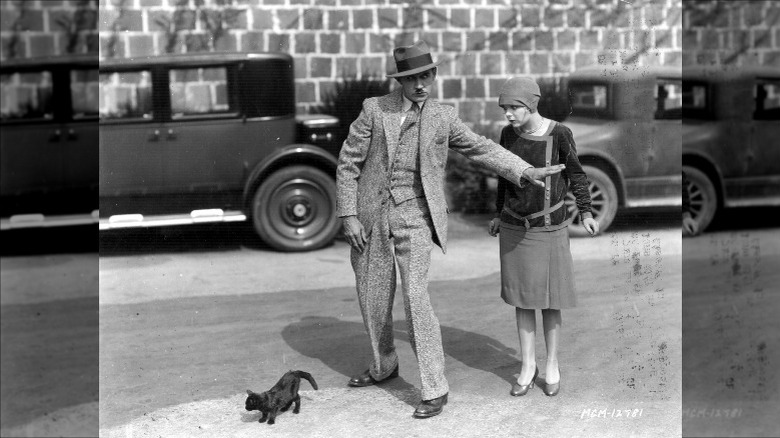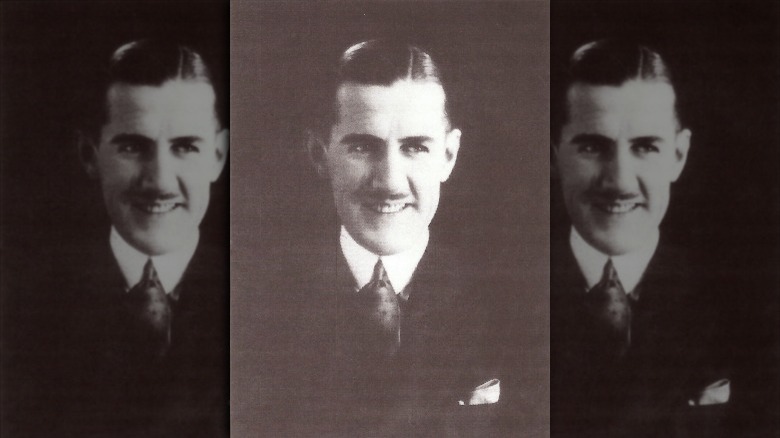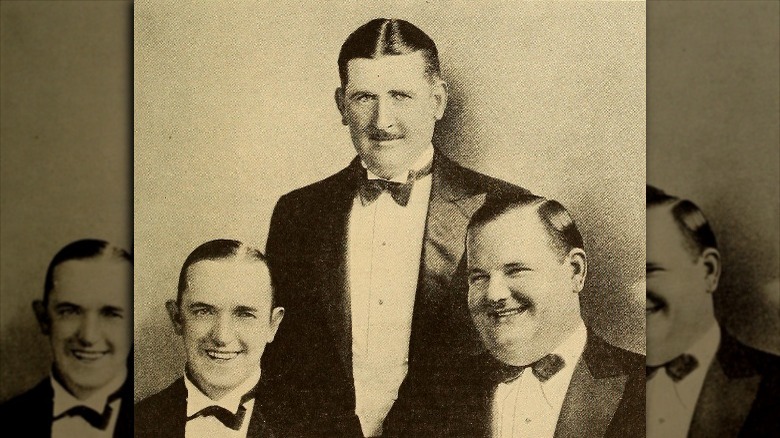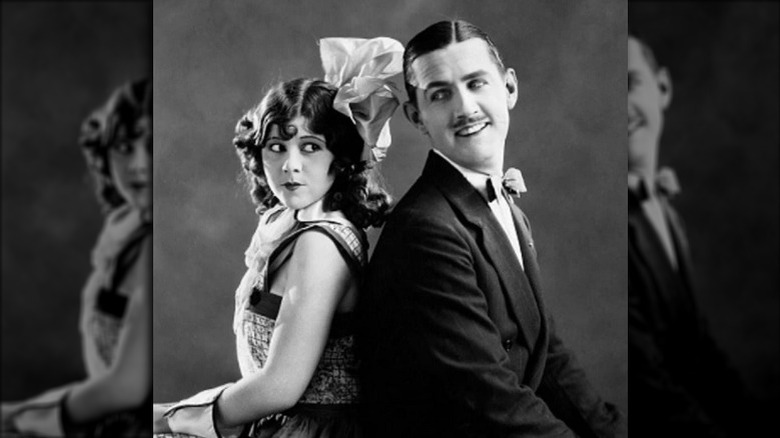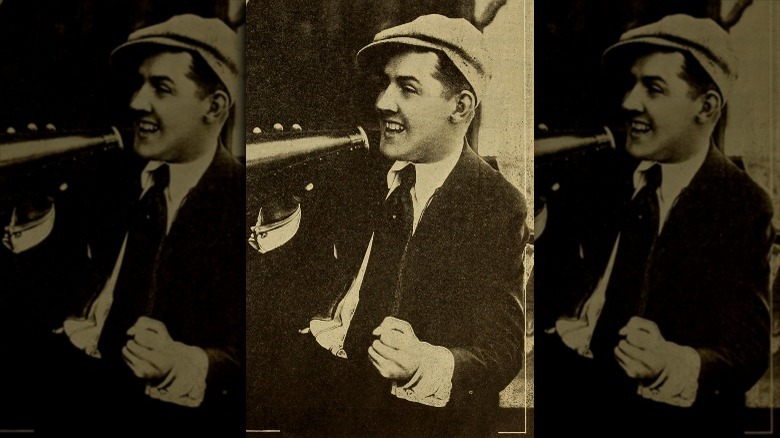The Tragic Real-Life Story Of Charley Chase
It's impossible to say what films will be remembered by future generations, the works that will endure beyond their immediate commercial performance. The films of Charlie Chaplin, Laurel and Hardy, and Buster Keaton have all endured, finding new audiences through the internet and those who come out especially to enjoy their work at prestigious public screenings around the world. But sadly, not all talent is remembered the way it deserves to be, and many of the greatest stars of the silent screen and the early era of the talkies are almost unknown to cinema audiences today. One figure who is deserving of greater attention is Charley Chase, a natural comedian who came to prominence during the silent age and made a rare successful transition to sound, according to Fandango.
Born Charles Parrott in Baltimore, Maryland, in 1893, Chase served his comedic apprenticeship in vaudeville before becoming one of silent comedy's leading lights, an all-round talent whose instinctive sense for cinematic humor came across on both sides of the camera. Chase made little impact in the bit parts he played in a number of shorts featuring Charlie Chaplin and Roscoe "Fatty" Arbuckle, but his nous as a director was evident immediately. According to Leonard Maltin, one of the earliest examples of his talent can be found in the 1923 short "Sold At Auction," which he directed the Australian funnyman Snub Pollard. In it, a snazzy bit of camera trickery simulates the blackout the protagonist suffers after a punch, in what Maltin calls "one of the most startling gags in silent films."
Natural talent and innovative use of cinema as a language in itself have typically seen screen comedians immortalized ... so why then is Charley Chase no longer a household name?
Chase's big feature-length break got cut
For many movie buffs, the importance of Charley Chase in the development of Hollywood comedy is indisputable. But per The World of Charley Chase, much of his influence was felt behind the scenes. His prodigious talent as a filmmaker saw him become the director-general of Hal Roach Studios — the premier comedy studio of the day — in 1921, where he helped develop what the same source describes as the Hal Roach style of screen comedy. Before long, Roach realized Chase's star potential, and the mid-'20s saw Chase take the lead in a glut of popular comedy shorts, such as "Crazy Like a Fox." In the same period, shorts such as "Dog Shy" and "Bromo and Juliet" saw Chase develop a continuous "Charley" persona, as Laurel and Hardy would when they formed their double act.
While Chase grew to become a famous face of the silver screen and was popular enough to be compared to many of his comedic contemporaries, film historians have argued that one aspect of his career prevented him from attaining the status of an all-time comedy great.
According to James L. Neibaur, in 1936, Roach decided to employ Chase to star in his first feature film. At the time, audience tastes were changing, with a greater number of experienced moviegoers keen to enjoy comedies with a run-time of an hour or more, rather than the short one or two-reeler comedies that lasted 10 or 20 minutes each. Chase's feature debut was slated to occur in 1936 in "Bank Night," but for financial reasons the full-length version never materialized. The project became yet another short, and Chase never made the all-important transition.
Charley Chase's unhappy marriage
Charley Chase's association with Hal Roach ended shortly after the studio failed to produce "Bank Night" as a feature. As described in Images, full-length movies had become far more lucrative for studios to produce, and Roach, keen to focus solely on the new format, failed to see Chase as a suitable feature star. After a brief return to vaudeville, Chase was signed to Columbia Studios in 1937, where he plied his trade as a star of shorts and as a director for the rest of his career.
Whether we agree or not that a single production decision could be enough to curtail the afterlife of the work of such a popular comedian as Charley Chase, accounts of his tumultuous private life show how circumstances colluded to cut his career tragically short. As James L. Neibaur notes, Chase struggled with alcoholism throughout his career, with many historians putting his heavy drinking down to his unhappy marriage to Bebe Eltinge, whom he had wed in 1914. The couple had two children, though Chase nevertheless made a name for himself as a socialite and party animal. By the 1930s, Chase's lifestyle was beginning to take its toll. According to Images, the comedian's screen appearances show him as prematurely aged during this period, and he had begun to descend into ill health.
If you or anyone you know is struggling with addiction issues, help is available. Visit the Substance Abuse and Mental Health Services Administration website or contact SAMHSA's National Helpline at 1-800-662-HELP (4357).
The tragic death of Charley Chase's brother, James
In 1939, Charley Chase — already unwell, with his career on the wane and his marriage in tatters — experienced the greatest tragedy of his life when he lost his younger brother, James Parrott, at the age of just 41.
Like Charley, James was a comedian, who starred in a number of Hal Roach films under a range of pseudonyms. He was also, like his brother, a well-regarded director and gag writer who worked extensively with Laurel and Hardy (pictured, with Parrott). However, he also shared his brother's proclivity for heavy drinking, and toward the end of the 1930s, his addiction began to affect his reputation. According to The World of Charley Chase, the younger Parrott brother was increasingly considered a liability and struggled to find work, eventually relying on Chase for financial support.
James suffered from epilepsy, a condition which, at the time, was treated with amphetamines, medication that purportedly led James down the path to drug addiction. On May 10 of that year, James reportedly took an overdose and suffered a fatal heart attack.
If you or anyone you know is struggling with addiction issues, help is available. Visit the Substance Abuse and Mental Health Services Administration website or contact SAMHSA's National Helpline at 1-800-662-HELP (4357).
Charley Chase was just 46 when he died
Charley Chase was reportedly devastated by the death of his brother James, a loss which exacerbated his addiction toward the end of what was a hard-drinking decade. As Images notes, Chase had been advised for years to reduce his alcohol consumption, which had caused him to develop stomach ulcers, and checked into a rehabilitation program at the Mayo Clinic. The loss of his brother, however, led Chase to drink with greater intensity than ever before.
Bright Lights Film describes the immense guilt that Chase felt following the death of James; James had grown entirely dependent on him, and in the weeks before his death, Chase had refused to supply his brother with money that he was sure he would use to fund his addiction. As many outlets have reported, Chase held himself responsible for his brother's death.
On June 20, 1940 — just 13 months after the loss of James — Chase himself died of a heart attack as a result of his drinking at just 46, his life and career cut tragically short.
If you or anyone you know is struggling with addiction issues, help is available. Visit the Substance Abuse and Mental Health Services Administration website or contact SAMHSA's National Helpline at 1-800-662-HELP (4357).
Charley Chase: the rediscovery of a comic genius
The historian Leonard Maltin shared the belief commonly held among comedy fans that Charley Chase's failure to be remembered among such luminaries as Charlie Chaplin and Laurel and Hardy is because his career rarely went beyond two reels; almost everything that Chase took the lead in was short, and as tastes changed, his contribution to cinema was increasingly overlooked. Maltin goes as far as to accuse Chase of lacking ambition. But many of Chase's shorts are bona fide comedy masterpieces, particularly 1927's "Movie Night," Chase's final silent film that James L. Neibaur calls the greatest of all Chase's comedies.
Despite the tragedies of his life, Chase was a natural funnyman, with comedy kingpin Hal Roach recognizing his innate humor as a friend as well as a performer. "He was one of the very few comedians who was just as funny off the screen as he was on. Charley was a delight to be with," Roach reportedly once said, per Maltin.
Thankfully, many of Chase's works have slowly attracted the acclaim they deserve after decades of critical neglect. In 1960, his name was finally added to the Hollywood Walk of Fame, while more recently some of his finest films have been honored for inclusion in both the Library of Congress film archive and that of the Academy of Motion Picture Arts and Sciences.
